
Emerson Fittipaldi is a Brazilian former automobile racing driver who won both the Formula One World Championship and the Indianapolis 500 twice each and the CART championship once.
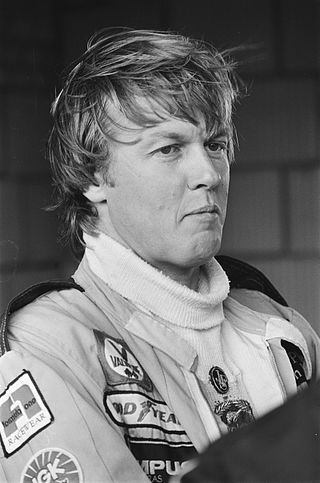
Bengt Ronnie Peterson was a Swedish racing driver. Known by the nickname 'SuperSwede', he was a two-time runner-up in the Formula One World Drivers' Championship.
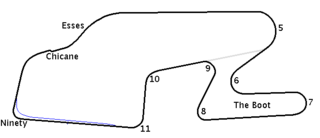
The 1975 United States Grand Prix was a Formula One motor race held on October 5, 1975, at the Watkins Glen Grand Prix Race Course in Watkins Glen, New York. It was race 14 of 14 in both the 1975 World Championship of Drivers and the 1975 International Cup for Formula One Manufacturers. It was the 25th United States Grand Prix since the first American Grand Prize was held in 1908 and the 18th since the first United States Grand Prix at Riverside in 1958.

The 1976 Brazilian Grand Prix was a Formula One motor race held at Interlagos in São Paulo, Brazil on 25 January 1976. It was the opening round of the 1976 Formula One season. The race was the fifth Brazilian Grand Prix and the fourth to be held for the World Drivers' Championship. The race was held over 40 laps of the 7.87-kilometre circuit for a total race distance of 315 kilometres.
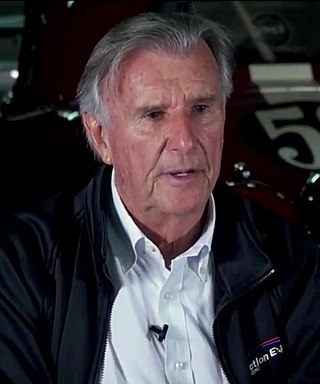
Wilson Fittipaldi Júnior is a Brazilian former racing driver and Formula One team owner. He participated in 38 World Championship Formula One Grands Prix, debuting on May 1, 1972, scoring a total of three championship points. He ran the Fittipaldi Formula One team between 1974 and 1982. He also participated in numerous non-Championship Formula One races.
Fittipaldi Automotive, sometimes called Copersucar after its first major sponsor, was a Formula One racing team and constructor that competed from 1975 to 1982. It was the only Formula One team to have been based in Brazil. The team was formed during 1974 by racing driver Wilson Fittipaldi and his younger brother, double world champion Emerson, with money from the Brazilian sugar and alcohol cooperative Copersucar. The team raced under a Brazilian licence. Emerson Fittipaldi became a driver for the team in 1976 after leaving McLaren, but was unable to replicate his earlier success with the family-owned team. Future world champion Keke Rosberg took his first podium finish in Formula One with the team.

Team Rebaque was a Mexican Formula One entrant and constructor, based in Leamington Spa, UK. They participated in 30 Grands Prix, initially entering cars bought from Team Lotus, before finally building a car of their own. The Rebaque HR100 was entered for the team's final three races before the team's closure. The team qualified to race on 19 occasions, and achieved one World Constructors' Championship point with its best finish of sixth at the 1978 German Grand Prix.
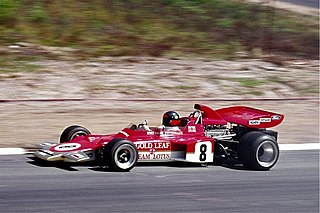
The Lotus 72 is a Formula One car designed by Colin Chapman and Maurice Philippe of Lotus for the 1970 Formula One season. The 72 was a pioneering design featuring inboard brakes, side-mounted radiators in sidepods, and aerodynamic wings producing down-force.

The McLaren M23 was a Formula One racing car designed by Gordon Coppuck, with input from John Barnard, and built by the McLaren team. It was a development of the McLaren M16 Indianapolis 500 car. A Ford Cosworth DFV engine was used, which was prepared by specialist tuning company Nicholson-McLaren Engines. This helped push the DFV's horsepower output to around 490 bhp.

Ricardo Ramsey "Richard" Divila was a Brazilian motorsports designer. He worked in Formula One, Formula Two, Formula Three, Formula 3000 and sports car racing.

The BRM P207 was a Formula One racing car, designed by Len Terry and constructed by British Racing Motors, which raced in the 1977 Formula One season. It was powered by a 3.0-litre V12 engine, with a claimed output of 488bhp. London-based Swiss watchmakers Rotary Watches provided sponsorship money. The car failed to score any points during the season. The team made a total of nine entries during the season, but only qualified in one instance, at the 1977 Brazilian Grand Prix. Driven by Larry Perkins, the car retired on lap one due to overheating. Its qualifying time was six seconds slower than that of the second-to-last starter. One British journalist in Brazil exclaimed that he was ashamed of being British. The car failed to appear at the season opening Argentine Grand Prix because it was too wide to fit in the hold of the aircraft that was going to transport it to South America.
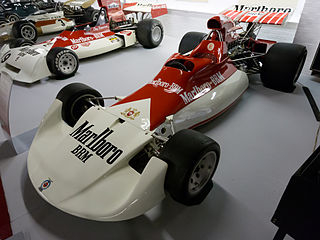
The BRM P180 was a Formula One racing car, built by BRM and designed by Tony Southgate which raced in the 1972 Formula One season. It was powered by a BRM 3.0-litre V12 engine. One of the main features of the P180 was that the radiators had moved to the rear of the car, allowing the nose of the car to be very wide and flat. It competed in five World Championship Grands Prix, with a total of seven individual entries. The car scored no World Championship points, its best finish being eighth at the 1972 Italian Grand Prix.
The Ligier JS7 was the second Formula One racing car made by Ligier. As with the preceding JS5, the letters "JS" were in tribute to Guy Ligier's friend Jo Schlesser who was killed in the 1968 French Grand Prix.

There have been 32 Formula One drivers who have represented Brazil, including three world champions. Ayrton Senna, the three-time title winner, is regarded by many as the best driver in the history of Formula One. Nelson Piquet also won the title three times and Emerson Fittipaldi was a two-time winner. Rubens Barrichello, who used to hold the record for the most races contested with 322 starts, finished as the championship runner-up in two seasons. Following the retirement of Felipe Massa after the 2017 season, in 2018 there were no Brazilian drivers entered for the World Championship, the first time this had occurred since 1969.
Haas Formula LLC, competing as MoneyGram Haas F1 Team, is an American-licensed Formula One racing team established by NASCAR Cup Series team co-owner Gene Haas in April 2014. The team originally intended to make its debut at the start of the 2015 season but later elected to postpone their entry until the 2016 season. The team principal is Guenther Steiner.

The Matra MS11 is a Formula One car used by the Matra team during the 1968 Formula One season, developed from the successful MS7 F2 car. It was relatively unsuccessful compared to its sibling, the Cosworth DFV powered Matra MS10 which Jackie Stewart drove to second place in the World Drivers' Championship. The major problems were with the V12 engine, which was thirsty, underpowered, unreliable and prone to overheating. The car was raced almost exclusively by Jean-Pierre Beltoise with Henri Pescarolo driving a second car at the end of the season. Its best outing came at the 1968 Dutch Grand Prix where Beltoise finished second behind Stewart, and recorded the fastest lap. In 1969, Matra set aside the V12 project, concentrating on the DFV-powered MS80.

The Fittipaldi FD was a series of Formula One chassis designed by Richard Divila and used by Fittipaldi Automotive in the 1975, 1976 and 1977 seasons. The initial chassis was designated Fittipaldi FD01 and there were three minor developments designated, Fittipaldi FD02, Fittipaldi FD03 and Fittipaldi FD04 respectively. FD series cars competed in 37 races making 43 individual entries in total. The chassis achieved a best finish of fourth place at both the 1977 Argentine and Brazilian Grands Prix driven on each occasion by former World Champion and joint team-owner Emerson Fittipaldi. It scored a total of 11 World Championship points.
The Fittipaldi F6 was a Formula One car designed by Ralph Bellamy and used by Fittipaldi Automotive in the 1979 Formula One season. The engine was a Ford Cosworth DFV, and the car was driven by Brazilian Emerson Fittipaldi but achieved no points during the season. The car was modified to become the F6A, used later in 1979 and was succeeded by the Fittipaldi F7.

Enzo Fittipaldi da Cruz is a Brazilian-American racing driver, who is currently competing in the FIA Formula 2 Championship with Carlin. After signing with Carlin, he became a member of the Red Bull Junior Team in November 2022, and was a previous member of the Ferrari Driver Academy. Fittipaldi was the 2018 Italian F4 champion and 2019 Formula Regional European runner-up. He then spent nearly two seasons in Formula 3 before being promoted to Formula 2 with Charouz Racing System.
















